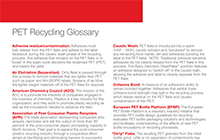Adhesive residue/contamination: Adhesives must fully release from the Polyethylene terephthalate (PET) flake and adhere to the label facestock during the caustic wash phase of the recycling process. Any adhesive that remains on the PET flakes or is “loose” in the wash cycle discolors the reclaimed PET (rPET) and lowers the yield.
Air Elutriation (Separation): Dirty flake is passed through this process to remove materials that are lighter than PET such as paper and film (BOPP) labels. Streams of air blow the lighter weight materials off of the PET flake for disposal.
American Chemistry Council (ACC): The mission of the ACC is to promote the interests of companies engaged in the business of chemistry. Plastics is a key industry for this organization, and they work to promote plastic recycling as well as the innovations needed to advance the field.
Association of Plastic Recyclers (APR): The trade association representing companies who acquire, reprocess and sell the output of more than 90 percent of the post-consumer plastic processing capacity in North America. Their goal is to expand the post-consumer plastics recycling industry through a cooperative effort aimed at identifying and eliminating barriers to successful commercial recycling.
APR Design™ Guide for Plastics Recyclability: A guide highlighting best practices in plastic package design and decoration to ensure the package is technically compatible with today’s recycling technology.
APR Recognition Program: A service that provides for the submission of fully decorated product containers (bottles and labels) to a third party laboratory for evaluation to determine their ultimate compatibility with the PET recycling process. Packages are put through a series of steps that replicate the recycling process. The resulting PET flake is then evaluated against a set of criteria and given a Pass or Fail rating. As a converter, gaining APR recognition is a key component of your value proposition to your targeted brand owner as it demonstrates your capability to provide a fully recyclable solution.
Bale: A compressed unit of PET plastic bottles, which maximizes the overall volume of materials for transportation to further processing facilities.
Caustic Wash: PET flake is introduced into a warm (140F - 180F), caustic solution and “scrubbed” to remove any remaining food matter, dirt and adhesives bonding the label to the PET flake. NOTE: Traditional pressure-sensitive adhesives do not cleanly release from the PET flake in this process. The Avery Dennison CleanFlake™ portfolio features an adhesive designed to “switch off” in the caustic bath, allowing the adhesive and label to cleanly separate from the PET flake.
Cohesive Bond: A measure of an adhesive’s ability to remain bonded together. Adhesives that exhibit lower cohesive bond strength may split in the recycling process, which leaves residue on the PET flake and causes contamination of the rPET.
European PET Bottle Platform (EPBP): The European PET Bottle Platform is a voluntary industry initiative that provides PET bottle design guidelines for recycling; evaluates PET bottle packaging solutions and technologies; and facilitates understanding of the effects of new PET bottle innovations on recycling processes.
“Dirty” Flake: The resulting PET granules from the initial bottle grind. Little or no separation of contaminants has occurred at this stage of processing.
“Clean” Flake: The resulting PET granules after full processing which are then suitable for use in manufacturing new plastics.
Food-grade rPET: Reclaimed PET flake that is FDA approved for re-use in the manufacture of plastic packaging for food grade applications. It is also referred to as “FDA Letter of No Objection rPET”.
Granulation (Grinding): The process of rendering PET packaging into a granular, or flake, state.
Ink Bleed: Some label inks bleed color when agitated in hot water and can discolor PET flakes in the reclamation process, which diminishes or eliminates its value for recycling. The APR and NAPCOR have developed a testing protocol to assist label manufacturers in evaluating whether a label ink will bleed in conventional PET reclaiming systems. Label inks must be chosen that do not bleed color when tested under this protocol. The use of label inks that bleed should be scrupulously avoided.
Ink Adhesion: The ability of an ink system to adhere to the label substrate on which it is printed. In the case of PET recycling, it is critical that the ink systems employed on the facestock remain bonded through the caustic wash process. Loose ink pigment will sink with the PET flake in the wash process and contaminate the rPET within the PET recycling process.
Plastics Recycling Facility (PRF): A recycling facility that accepts only plastics. They separate bottles by color and composition and often grind them for shipment to reclaimers as “dirty” flake.
Material Recovery Facility (MRF): A recycling facility that accepts commingled curbside recyclables and separates them into their respective material categories. PET bottles and containers are separated and baled for sale to PET reclaimers for further processing.
National Association for PET Container Resources (NAPCOR): The trade association for the PET plastic packaging industry. They promote the introduction and use of PET packaging; facilitate its recycling; and communicate the attributes of the PET container as an environmentally sustainable package.
Near Infrared Spectrometry (NIR) Sorting: The automated identification and separation of plastics by type (i.e. PET, HDPE) for additional sorting and processing. NIR sensors are utilized to identify the color and type of the container resin as an initial step in the sorting process.
Pressure-sensitive (PS): Adhesives that adhere to a variety of substrates when applied with pressure. No solvent, water or heat is necessary to activate the adhesive.
Reclaimer: A recycling facility that processes containers into “dirty” flake and then into the final “clean” flake reclaim for use in the manufacture of new plastic materials.
rPET: rPET stands for recycled polyethylene terephthalate, or recycled PET. It can be made into such products as blankets, insulation, car parts, shoes and more.
Shrink Sleeves: Typical shrink sleeves are produced from PETG, PVC or Polystyrene based resins. They are a primary source of contamination in the PET recycling process because they have a density greater than 1.0. This causes the label material to sink with the PET flake in the Sink/Float separation process. Fully printed shrink sleeves can also interfere with the NIR sorting process which is used to identify the type of plastic the container is composed of and separate various plastic streams for further processing.
Sink/Float Separation: PET flakes, which are heavier than water, sink to the bottom of the classifier. BOPP labels, which are lighter than water, float to the surface of the classifier and are then skimmed off and removed. In this step it is critical for the labeling material to have a density less than 1.0, or it will sink to the bottom of the classifier, resulting in contamination of the PET flake.
Utilization Rate: The PET utilization rate is expressed as the amount of clean flake produced from U.S. bottles compared to the recycling rate. In 2013, the recycling rate was 31.2%. The utilization rate was 22.6%. This reflects a loss of nearly one third of the flake produced from recycled bottles. The utilization rate is heavily impacted by various types of contamination, including labels and adhesives. U.S. reclaimers have reported yield losses ranging from 25% for deposit bottles to 35% for curbside material.
Virgin PET: Resin created using virgin petro-chemical inputs and no post-consumer recycled content.
Water Whitening: The result of an adhesive system re-emulsifying or “blushing” in the presence of water or moisture. Water whitening is a defect manifested by the adhesive turning a milky color in the affected areas. This is a critical failure mode for “clear on clear” labels where appearance and shelf appeal are primary requirements.
Yield/Quality: The two most important factors in all reclamation operations are yield and quality. Any attachment or decoration on a plastic bottle, such as closures, closure liners, base cups, inserts, labels, pour spouts, handles, sleeves, safety seals, coatings and layers can impact the recovery rates. Lower rates reduce yield and can increase recycling costs. These items, when not compatible with the recovery of base resin, represent a significant cost to the processor in terms of separation, recovery and waste disposal; furthermore, it can have an adverse effect on the quality of the post-consumer resin (PCR) produced.


